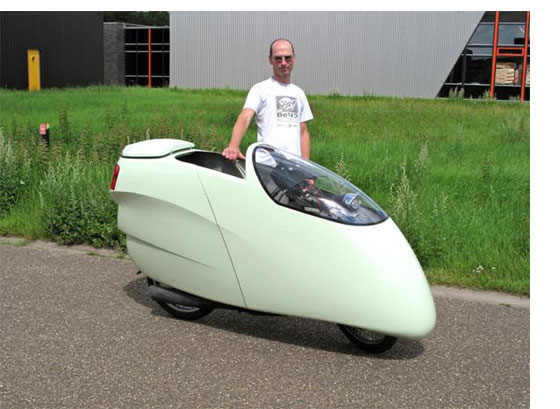
Dutch efficiency enthusiast Allert Jacobs has converted his new Honda motorbike into a streamliner capable of getting over 200 mpg (US) cruising at 55 mph.
The Honda ANF125i Innova was pretty efficient right out of the box, since it followed the basic formula for low fuel consumption: small size + light weight + modest engine power.
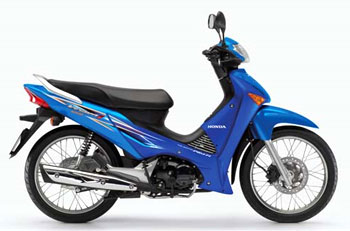 The bike tips the scales at just 231 lbs (105 kg) and features an efficient, fuel injected, four stroke 125cc single, producing 9 hp (6.85 kW).
The bike tips the scales at just 231 lbs (105 kg) and features an efficient, fuel injected, four stroke 125cc single, producing 9 hp (6.85 kW).
With those specs, the Honda already offered great fuel economy:Â Allert’s first five fill-ups delivered 133 mpg (US) (1.8 L/100 km) over 638 miles (1027 km).
(With a disclaimer: he figures that’s better than “normal” because he was babying the bike while breaking it in. He says a more realistic figure for his driving is 114 mpg (US) – that’s what he got from the last two fill-ups before he started modifying it.)
Q: How do you get from 114 mpg to over 200 mpg?
A: aerodynamics first (and gearing second)
Being a long time cyclist, motorcyclist and velomobile enthusiast, Allert intuitively understands what many people either don’t know or greatly underestimate: the enormous impact of aerodynamics on fuel consumption.
Unlike the average person, he is not surprised by the fact that a typical car burns 50% of its fuel overcoming air resistance at just 40 mph (64 km/h). Or that the higher drag of a typical motorbike means half of its fuel is used to overcome air drag at just 15 – 20 mph (24 – 32 km/h)!
Custom aerodynamic fairing:Â velomobile influence (version 1)
Allert knew he could significantly reduce the amount of power required to go down the road by lowering the rider’s position (reducing exposure to the oncoming air) and then reducing turbulence by adding smooth fairings.
His extensive experience designing and producing recumbent bicycles and fully enclosed recumbent velomobiles obviously prepared him for this project. (Above photo: Allert’s commercially produced Quest velomobile, a pedal-powered trike)
Diving in feet first
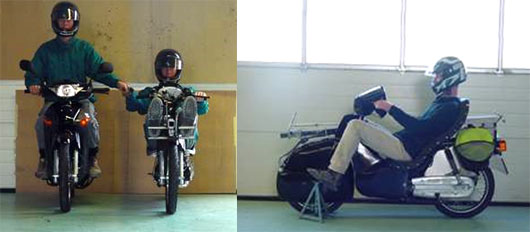
Reducing frontal area showed immediate results. To get a feet-forward position on the Honda, a new seat was mounted in the bike’s step-through area, and the foot pegs and controls were moved to just above the front wheel. The front wheel itself was enclosed, and another fairing was added ahead of the rider.
(Most motorcycle owners have probably experienced the benefit of reducing frontal area and drag, simply by tucking down at higher speeds and feeling the bike speed up without moving the throttle. It’s a good demonstration that shows aerodynamics isn’t only about fuel economy!)
On his first test drive, the drag reduction was obvious. Even lacking critical bodywork needed to smooth airflow at the rear of the bike, the little Honda’s top speed went up from 90 km/h (56mph) to 110 km/h (69mph).
Taller gearing
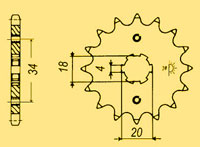 Because the modifed bike now required less energy to go down the road than the stock version, its gear ratios could be optimized: engine RPM could be lowered for a given speed that would have lugged the engine before the aero mods. Reducing engine speed normally improves fuel economy.
Because the modifed bike now required less energy to go down the road than the stock version, its gear ratios could be optimized: engine RPM could be lowered for a given speed that would have lugged the engine before the aero mods. Reducing engine speed normally improves fuel economy.
With the new sprockets in place, fuel economy was now up to 152 mpg (1.55 L/100 km) over 1901 miles of riding (3059 km).
But Allert wasn’t happy! He wanted more…
Lessons learned from version 1
- Stability issues with the front wheel fairing: side winds were affecting stability, because steering force was being transmitted to the forks. “It turned out to be very scary to ride even with as little as 3 Beaufort (about 10mph) side wind. I did not dare to go over 35mph.” That would have to change.
- Manual clutch conversion: with the taller gearing, Allert wasn’t happy with the Honda’s stock semi-automatic shifting. He added a clutch lever & cable and converted to a full manual transmission so he could control the amount of slip needed for a smooth start, since “the first gear is now almost as long as the second gear used to be”.
- Revised aerodynamic fairings: to reach his efficiency goals, the aerodynamics of version 2 would have to be better.
Version 2: best tank = 214 mpg (US); average = 199 mpg
The photos below speak for themselves (click to zoom). Allart spent months crafting full length bodywork, divided in two sections. The front half slides forward in a clever setup that allows the rider to get “in” and “out” of the bike fairly easily.
The windshield is less for forward vision than a place to locate the LED turn signals to keep them out of the wind. Allert added signals on the side mirrors as well.
He’s happy with the stability of the full length fairing compared to the first version: “A 40mph (65 km/h) side wind is no problem,” though more than that he hasn’t experienced yet.
And it works: in cool, windy weather, he managed 214 mpg (US) or 1.1 L / 100 km on a 160 mile (km) round trip.  His goal is 235 mpg on a trip cruising at 55 mph (90 km/h). Why 235 mpg? Because its metric equivalent (as is used in the Netherlands) would be a very impressive 1 liter per 100 kilometers.
He expects that’s possible in ideal conditions (warm & calm), though he’s not simply waiting for better weather to accomplish this feat. He notes that the fairing isn’t entirely optimized from an aerodynamic perspective, and is also investigating potential improvements in rolling resistance (by methodologically testing different brands of tires on a custom made test rig).
When spring & summer roll around this year, I have little doubt that 1L / 100 km is in the cards for Allert Jacobs.
We’re looking forward to seeing more from this man!
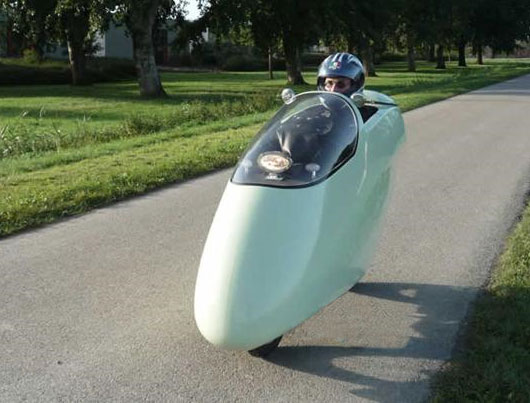
(Photos: Allert Jacobs. Used with permission.)
| Aerodynamics: a weighty matter
Allert Jacobs added 88 lbs / 40 kg worth of aerodynamic modifications to his bike. He admits he didn’t try particularly hard to fabricate light parts, so his Honda now weighs 43% more (!) than it did when he bought it.People who aren’t familiar with the subject of aerodynamics often predict (mistakenly) that the extra weight of aero mods will hurt fuel economy more than reducing drag will help. Obviously that’s not the case here. Aerodynamic improvements trump weight. The exception may be for vehicles that spend the majority of their time in heavily congested urban traffic at very low average speeds. Clearly that’s not Allert’s situation. In fact he figures the added weight on the Honda is a benefit because “it will make it more stable in side wind situations.” |
.
For more information:
- For the latest information & photos, visit Allert Jacob’s web site documenting this project
- Craig Vetter is one of the godfathers of motorcycle efficiency enthusiasts. Read about his own on-going high mileage motorbike project, the Freedom Machine.
- EcoModder member Janvos has been working on similar aero & gearing mods to his Suzuki Burgman. Follow his progress in this project thread.
More projects featuring aerodynamic modifications:
Popularity: 100% [?]

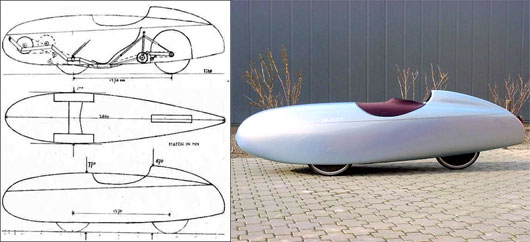


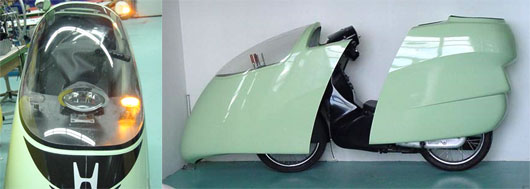
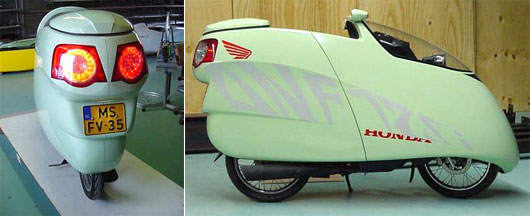






{ 20 comments }
Common sense tells me you need someone to hold up the bike while you get into riding position and you have no way to stop without someone to catch you. Yes?
It’s not clear from the photos, but the fairing is open on the bottom. The rider can put a foot/feet down just as before.
Check the builder’s web site for photos showing this.
From the project log:
“The bottom of the fairing will stay open to be able to put my feet down and balance the machine when I stop and to let air in to cool the engine.”
Are there any bikes like this currently in production? Even from smaller companies just modding pre-existing bikes? It doesn’t look particularly difficult to do, or even develop a kit for.
You do know that Craig Vetter had a similar design, and got 470 mpg , some 30 years ago, right?
http://www.craigvetter.com/pages/470MPG/Vetter%20Fuel%20Economy%20Contests.html
DIY sweetness!
Want for auranthetics.
Very Sleek!
hello im josh bolen and ok here goes.i any looking for a investor of a new electric car i invented.this new car needs no recharge.this car does not run or charge off solar power it is a totally fossil free vehicle.i have been researching this for some time now and come to conclusion this technology needs to been now and just because im a high school dropout and many people want believe it is possible to run a electric car without having to recharge it after some time of driving while there wrong i have.i am a inventor and have many inventions that people want believe could have been invented by a high school drop out. but everyone forgets to note that many of the worlds great inventors were just like me.i am just looking for someone to invest in me and let me prove everyone wrong and that this car is the future of automobiles and that it would be a lot faster and go further that anything we know of today.if there are any investor out there looking to make there money back 100 fold then this is my proposal i need 1.5 million to build 3 different types of this car such as a truck model a van model and a car model to showcase the unbelievable capabilities of this new technology.if there are any investor out there willing to give me a chance to showcase my skills in this new automotive technology then please email me aladen619@gmail.com or call me to set up a meeting near my home then heres the number 704-619-0115 .this offer is open to public or private investors so please if this sounds interesting to you then dont be to late make the call or send the e-mail you will not be disappointed
That is the coolest thing I’ve seen in a long time! I can’t believe that he got such mileage with that, very nice! Probably the only thing holding it back now is engine combustion efficiency.
I like your electric car what a ideal conditions. I stop and to let air in to cool the engine. Sounds very Interesting. Isn’t it a case of the underdog taking on the culture of its conqueror’s as succor? Isn’t it irresponsible, reckless, even daft,to herald this as the dawn of a new era? Wouldn’t you like to hear of sponsoring culture, for its color, of viewing reverently the traditional as having been distilled over countless generations, a continual gradual improvement. There’s every possibility that in consistent fashion the west will trample upon all those around heedless of the spiritual wealth of one of the worlds oldest countries, ruining others, and ruining itself in the process.
I dare you to vaunt the merits of this Car.
Thanks
Johnmclrn
There are advantages in expressing fuel usage in terms of distance traversed. In the modern, SI way, this is often: (say) “1 L/100 km”. Once one becomes more ‘fluent’ in SI, an even more compact version is “10 L/Mm”. [Ie. we count metres 1 million at a time instead of 1 thousand at a time.]
Duncan
I really enjoyed reading the information on your 125cc Super mpg machine. This is what it takes to get the kind of fuel mpg that this world needs. I own a 50cc French moped “Motobecane 50V”, and thought that 90-100 mpg was great. Not very user friendly when it comes to running up to the store for a few items. Yes, I understand that this machine has only one objective “Mileage”.
good job!
The fairing is gorgeous. He did some great work.
As for practicality, It seems there’s actually plenty of room under the fairing, so it should be easy to add some storage in future revisions.
This bike is really well done! Mayby I make one myself some day.
I would definitely use that simple technology as stabiliser for this bike.
http://www.youtube.com/watch?v=PyK-9cD20YI&feature=related
I would love to build a bike like that and have been looking for something like the Honda 125cc to do it with. However, I have been unable to find anything even close to it in style, CC’s and manual tranny. Any ideas for something to be built in the states…?
Thanks, Mike :{)
Do we know if he made it?
In any case, in order to achieve the 1/100 goal Allert would need to slow down!
It’s funny, but people think that 55mph is some magical number that vehicles all travel most efficiently at. But it’s just not so.
Does anyone from the UK remember the Mini Metro? They touted the car’s amazing 82mpg but when you read the fine print you found out that this was achieved at **30mph**!!!
Provided you’re not encumbered by an auto transmission you can get phenomenal mileage by simply driving slowly. The problem is that this is impractical (to say nothing of dangerous) in most situations. Pity.
That’s the point of aerodynamics … to raise that speed where a vehicle is reasonably efficient. Aero mods have very little effect at 30mph. If this (http://www.angelfire.com/retro/minimetroland/) is the car you’re talking about, mediocre aerodynamics were certainly a contributing factor to needing that low speed to get the mileage.
@Mike #16
I’ve been thinking about the Honda SH 150i for use in a similar project. It would need a swap to a manual gearbox (comes with CVT stock), but even the stock transmission gets pretty good mileage. The frame is conducive to a recumbent seat (reduces frontal area), and its stock tall wheels and water cooling would make for a great combo for higher-speed riding. Gets about 70mpg and does 70-75mph stock – seems like a good platform to for a project like Allert’s.
I think the hard part is creating the streamline.
We are a retail store, not a manufacturer, so we carry products from many different brands. Our main competitors are other bamboo product manufacturers, and 4 or 5 shops like ours that carry all different bamboo products. Our advantage is in our selection, because we carry so many different brands.
And we’ve been doing this for 5 years, making us the oldest all-bamboo store there is.
On our blog we discuss issues related to environmental awareness, green living, natural lifestyles. Sometimes we also write about local issues for our community,
and about topics related to Buddhism, yoga, zen and eastern philosophy.
“We will have to share this on our blog http://www.bambubatu.com/blog/ and with our facebook fans. I hope you can do the same for us!”
Comments on this entry are closed.
{ 10 trackbacks }